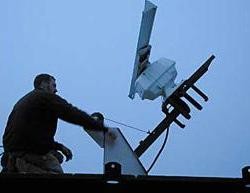[
{
"name": "Top Stories Video Pair",
"insertPoint": "7",
"component": "17087298",
"parentWrapperClass": "fdn-ads-inline-content-block",
"requiredCountToDisplay": "1"
}
]
I crept along, trying to keep my skittish white pickup on the narrow road that climbs above Bear River Ridge while peering the few visible feet ahead into a white swirly fog. One missed turn at a rash 15 mph, it seemed, and I'd be floating free, descending through the foggy gray twilight to a crumpled rest in some green-gold hollow ashimmer with the day's last light. The sun had set, and I had a rendezvous somewhere on the top of this ridge with a man in a white van who had promised to any takers at a recent Audubon/Sierra Club gathering that he'd show them his radar beam. And his nightvision goggles. And his three million candlepower spotlight which, if its red filter were accidentally torn off, would melt your eyes.
At last I came upon the white van parked in the white dark. Apparently I was the only taker this night. Peter Sanzenbacher got out of the van saying "Brrr" as the wind slammed into him, and climbed the ladder to the top of the van to crank up the radar beam so its long arm, when activated, would sweep around in horizontal circles. (Later, he would crank up the beam to a vertical position to sweep the heights.) Back on the ground, he opened the side door of the van and we got in. Inside was just one boring gray box -- a Furuno marine radar unit, just like they use on tugboats. "Most people are surprised," Sanzenbacher said. Think surveillance van and you expect a bank of monitors, gadgets and switches.
The radar van belongs to ABR Inc., an environmental research outfit from Oregon whose scientists have been gathering data on birds and bats for Shell WindEnergy. Shell wants to plant up to 35 wind turbines up here to generate electricity. And there are all sorts of issues to sort out, including the effect the proposed 256-foot-tall towers and their 130-foot-long blades might have on migrating airborne critters.
Each year, about a billion birds are killed by human-made structures (including cars) in the U.S., said a report published this May by the National Academy of Sciences. And in 2003, up to 37,000 of those billion collided with wind turbines. As more and more wind farms crop up, the report said, that number could rise exponentially -- making better research and regulation essential.
Most birds, including songbirds, migrate at night -- to stay cool and to avoid the daytime-migrating raptors, said Sanzenbacher. But not many targets passed through the radar beam that Wednesday night. Sanzenbacher said they'd noted that fewer birds fly over when it's foggy. When a series of little dots did show up on the screen, Sanzenbacher held up a little plastic white card with tick marks on it and measured the target's flight speed and direction. If the radar arm were pointed up, he'd measure the target's height above the ground. In this way, he could collect data on how many targets were passing through the turbine zone of potential death.
Before leaving, I asked Sanzenbacher for his take on wind energy. "I'm definitely a promoter of green energy," he said. "But like with anything, there's good places to put them and bad places." It's his job, he said, to collect the data that the developers and regulators will use to decide which kind of place Bear River Ridge might be. "And one fortunate thing about this project," he said, "is you can go to the Shell website and download all of these reports." Not all developers are so transparent, he said.
more from the author
-
From the Journal Archives: When the Waters Rose in 1964
- Dec 26, 2019
-
Bigfoot Gets Real
- Feb 20, 2015
-
Danger at McCann
A kayaker's death has raised safety questions about low-water bridges
- Feb 19, 2015
- More »
































